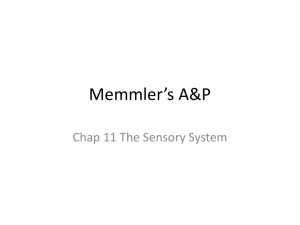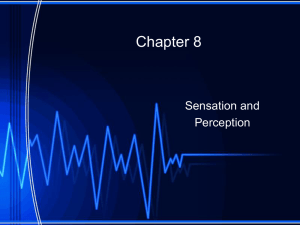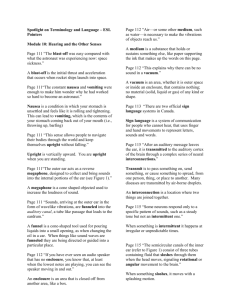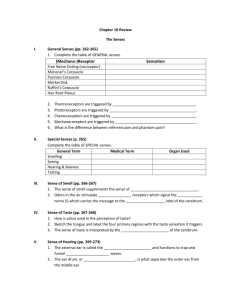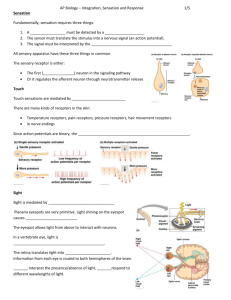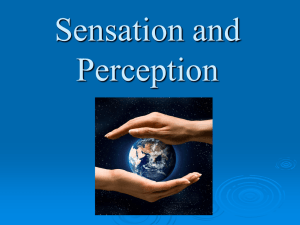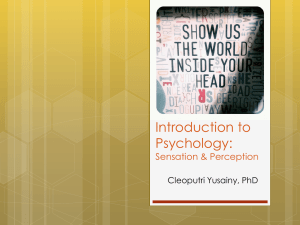Sensory and Perception
advertisement
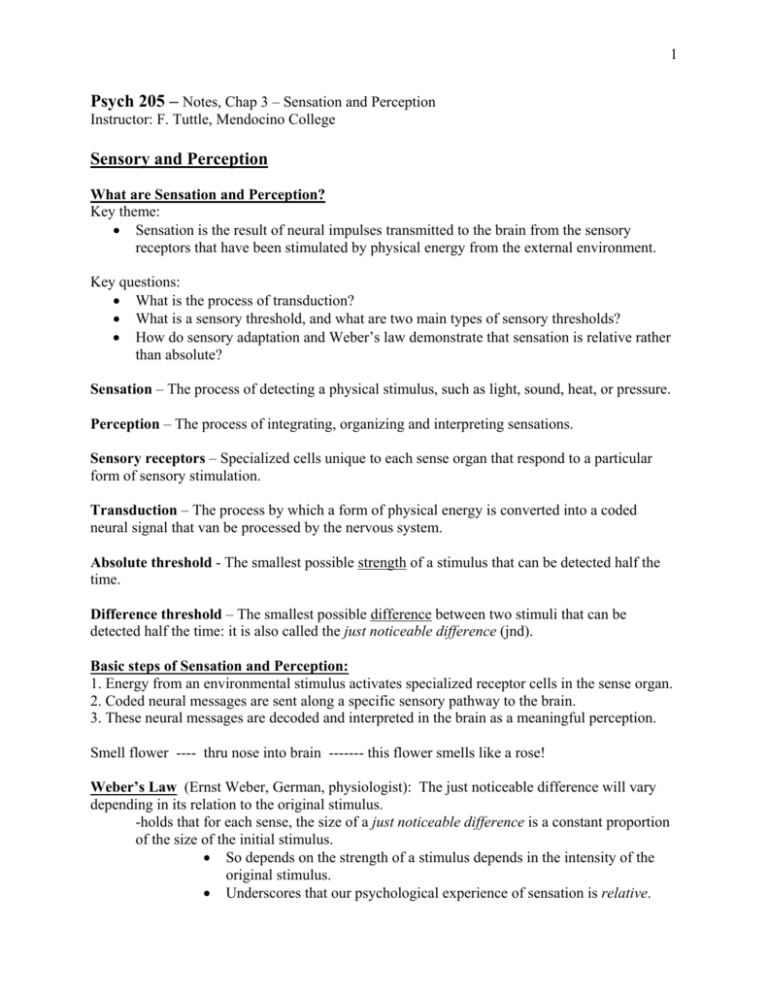
1 Psych 205 – Notes, Chap 3 – Sensation and Perception Instructor: F. Tuttle, Mendocino College Sensory and Perception What are Sensation and Perception? Key theme: • Sensation is the result of neural impulses transmitted to the brain from the sensory receptors that have been stimulated by physical energy from the external environment. Key questions: • What is the process of transduction? • What is a sensory threshold, and what are two main types of sensory thresholds? • How do sensory adaptation and Weber’s law demonstrate that sensation is relative rather than absolute? Sensation – The process of detecting a physical stimulus, such as light, sound, heat, or pressure. Perception – The process of integrating, organizing and interpreting sensations. Sensory receptors – Specialized cells unique to each sense organ that respond to a particular form of sensory stimulation. Transduction – The process by which a form of physical energy is converted into a coded neural signal that van be processed by the nervous system. Absolute threshold - The smallest possible strength of a stimulus that can be detected half the time. Difference threshold – The smallest possible difference between two stimuli that can be detected half the time: it is also called the just noticeable difference (jnd). Basic steps of Sensation and Perception: 1. Energy from an environmental stimulus activates specialized receptor cells in the sense organ. 2. Coded neural messages are sent along a specific sensory pathway to the brain. 3. These neural messages are decoded and interpreted in the brain as a meaningful perception. Smell flower ---- thru nose into brain ------- this flower smells like a rose! Weber’s Law (Ernst Weber, German, physiologist): The just noticeable difference will vary depending in its relation to the original stimulus. -holds that for each sense, the size of a just noticeable difference is a constant proportion of the size of the initial stimulus. • So depends on the strength of a stimulus depends in the intensity of the original stimulus. • Underscores that our psychological experience of sensation is relative. 2 Vision The Nature of Light: Why light? = original stimulus Various types of electromagnetic energy differ in wavelength. (x-rays, microwaves) Refer to Figure 3-2. Pg . 90: A Cross Section of the Human Eye. Human capable of detecting only a miniscule portion of the electromagnetic energy range. The different wavelengths of visible light correspond to our psychological perception of the different colors. 750 700 600 500 400 350 ____________________________________________________________ Red Yellow Green Blue-Violet Long middle short Wavelengths in nanometers (billionths of a meter) Meter = 3 ft. Refer to Figure 3-4. Pg. 91: The Electromagnetic Spectrum. Refer to Summary Table. Pg. 92: Rods and Cones. How Do We See? Cornea – A clear membrane covering the visible part of the eye that helps gather and direct incoming light. Pupil – The opening in the middle of the iris that changes size to let in different amounts of light. Iris – The colored part of the eye, which is the muscle that controls the size of the pupil. Lens – A transparent structure located behind the pupil that actively focuses, or bends, light as it enters the eye. Accommodation – The process by which the lens changes shape to focus incoming light so that it falls on the retina. Myopia: nearsightedness – distant objects appear blurry, because the light reflected off the objects focuses in the front of the retina. Presbyoia - middle age, another form of farsightedness, brittle and inflexible. Astigmatism – and abnormally curved eyeball results in blurry vision for lines in a particular direction. Corrective lens bend light to fall properly on the lens. 3 Color Our experience involves three properties of color: Hue: varies with the wavelength of the light. Different wavelengths correspond to our subjective experience of different colors: red -bl/violet Saturation (or purity) of the color corresponds to the purity of the light wave. Red vs. pink – red a single light wavelength – pink combo of red/white Brightness: perceive intensity. Corresponds to the amplitude of the light wavelength – higher the wavelength, the greater the degree of brightness. Normal person with normal vision – 120-150 color variations based on hue alone! Factor in saturation and brightness = millions (Bornstein and Marks, 1982) Color = determined by the wavelength of the light the object reflects. How We See Color: First scientific theory of color vision, mid-1800’s – Hermann von Helmholtz (1821 – 1894) The Trichromatic theory = recall only cones involved in color vision. • Each cone especially sensitive to certain wavelengths • Simplicity – refer only to red sensitive, green sensitive, blue sensitive. • When any other color strikes the retina = combination of cones • Extensive research in 1964 by George Wald – red, green, blue The Opponent-Process Theory – trichromatic cannot account for all color vision. Explains the “afterimage” = a visual experience that occurs after the original source of stimulation is no longer present. - there are four basic colors – divided into two-pairs of color-sensitive neurons: red-green, blue-yellow - the members of each pair oppose each other: if red stimulated, green inhibited, vice versa Note: black and white act as an opponent pair. If we stare continuously at one color – adaption eventually occurs, receptors become less sensitive to that color. Refer to Figure 3-7. Pg. 93: An Afterimage. Refer to Figure 3-9. Pg 94: The Neural Connections of the Visual System. 4 Hearing: From Vibration to Sound Key theme: Auditory sensation, or hearing, results when sound waves are collected in the outer ear, amplified in the middle ear, and converted to neural messages in the inner ear. Key Questions: 1. How do sound waves produce different auditory sensations? 2. What are the key structures of the ear and their functions? 3. How do place theory and frequency theory explain pitch perception? Audition = response to a wide range of sounds – from faint to blaeing, simple to complex, harmonies to discordant. Important to survival, social interaction, and language development. The Nature of Sound: Sound waves are the physical stimuli that produce our sensory experience of sound. - produced by rhythmic vibration of air molecules, but sound waves can be transmitted through other media – water. Amplitude – the loudness determined by intensity – units of measurement = decibels. Pitch – relative “highness” or “lowness” of a sound. Determined by the frequency (rate of vibration) of the sound wave. Most of the sounds we hear are complex – several sound wave frequencies. (timbre= distinctive quality, able to easily distinguish between same note on sax or piano) Refer to Figure 3-16. Pg. 99: A Decibel Scale for Several Common Sounds. Refer to Figure 3-17. Pg. 101: How We Hear. Path: Ear = outer ear, middle ear and inner ear. Sounds collected in outer ear, amplified in middle ear, and Transduced (converted to neural messages) in the inner ear. Outer ear = pinna – flap of skin attached to head. The ear canal – where ear drum located Ear drum separates the outer ear from middle ear. Three tiny bones: the hammer, the anvil, stirrup – oval window (a membrane) Oval window separates the middle ear from the inner ear. Cochlea – fluid filled tube coiled in spiral (Grk for snail)( no larger than pea) Travels to basilar membrane (sensory receptors for sound) - hair cells (auditory nerves) 5 The Chemical and Body Senses Vision and hearing get a lot of attention because humans rely primarily on these two senses to gather information about their environment. . Key Themes: Chemical stimuli produce the sensations of smell and taste, while pressure and other stimuli are involved in touch, pain, position and balance sensations. Key questions: 1. How do airborne molecules result I the sensation of an odor? 2. What are the primary tastes, and how does the sensation of taste arise? 3. How do fast and slow pain systems differ, and what is the gate-control theory of pain? 4. How are the body sensations of movement, position and balance produced? Smell, Taste and Position Smell and taste are chemical senses Smell: produced by molecules in the air. We inhale them through the nose and through the opening in palate at the back of the throat.. • In the nose, the molecules encounter millions of olfactory receptor cells located high in the nasal cavity. • Each odor receptor seems to be specialized to respond to a different chemical structure. • Estimated can detect 10,000 different odors. How we smell remains an open question. • Odor binding protein (OBP) a fine mist sprayed through a duct in tip of nose as we breathe. • OBP binds with receptor cells high in nasal cavity. • Axons of these receptors go directly to the olfactory bulb where recoding takes place. Odor sensitivity is gender related. • Usually women have a better sense of smell than men. • Age is a factor: sharpest during early adult years. The presence of a secondary sensory (smell) system: Receptors in the roof of the nasal cavity detect chemicals called pheromones Pheromones can have specific and powerful effects on behavior. Taste Note: taste is not flavor. Why? Four basic taste qualities: sweet, sour, salty and bitter Receptor cells for taste are housed in taste buds found on the tip, sides and back of tongue. What are the bumps on our tongue called? What’s located there? What has this to do with taste? Taste like other sense experiences adaption. Name a ‘taste adaption’ scenario for you? Refer to Figure 3-20. Pg. 106: The Structure of a Taste Bud. 6 Position or Kinesthetic and Vestibular Senses Kinesthetic senses: senses of muscle movement, posture and strain on muscles and joints. Stretch receptors are those that sense muscle stretch and contraction. Golgi tendon organs are receptors that sense movement of the tendons, which connect muscle to bone. Vestibular senses are the senses of equilibrium and body position in space. Used to determine up and down. Originates in the inner ear (like what other sense?) where hair cells serve as sense organs. Name the two vestibular sensations. 1 - Speed and body rotation 2 – gravitation movement: forward and backward, up and down The Skin Senses The skin is the largest sense organ. Name three functions the skin serves- as per text. The skin nerve receptors vary in concentration throughout the skin surface. Receptors send nerve fibers to the brain by two routes: Use Figure 2-8 to refresh your memory of the locations. Skin receptors give rise to sensation of pressure, temperature and pain, but the relationship between the receptors and sensory experiences is quite subtle. Skin senses are sensory adaptive. What example does the text use? Can you relate? Touch – skin sensory receptors Pascinian corpuscle – sensitive to pressure Pain – when nociceptors are stimulated. Fast and slow pain transmission Gate-control = explain how psychological and other factors influence the subjective experience of pain. Refer to page 109 for an explanation of the “neurological gate”. There is no simple relationship between pain receptors and the experience of pain. Are pain receptors easy to find? What is pain threshold? And what is pain tolerance? Observer Characteristics (diversity –universality) What personal factors influence our perceptions? These affect our perceptual experience (7): motivation, values, expectations, cognitive style, experience and culture, as well as personality.
